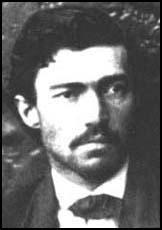Samuel Arnold

Samuel Arnold was born in Georgetown, on 6th September, 1834. Later the family moved to Baltimore and later Arnold attended St. Timothy's Hall Military Academy, at Catonsville, Maryville. It was while at this academy he met John Wilkes Booth.
Arnold joined the Confederate Army at the beginning of the American Civil War, but was discharged for health reasons in the summer of 1864. He returned to Baltimore but was unable to find work.
In 1864 John Wilkes Booth devised a scheme to kidnap Abraham Lincoln in Washington. The plan was to take Lincoln to Richmond and hold him until he could be exchanged for Confederate Army prisoners of war. Booth persuaded Arnold to join the plot. Others involved included George Atzerodt, Lewis Paine, John Surratt, David Herold and Michael O'Laughlin. Booth decided to carry out the deed on 17th March, 1865 when Lincoln was planning to attend a play on the outskirts of Washington. The kidnap attempt was abandoned when Lincoln decided at the last moment to cancel his visit.
Arnold now appeared to lose interest in the plan to capture Abraham Lincoln. He argued that the government had resumed prisoner exchanges with the Confederacy and it was no longer necessary to take such drastic action. Arnold returned to Baltimore before moving on to take a clerk's job in Old Point Comfort, Virginia. On 27th March, 1865, Arnold wrote a letter advising John Wilkes Booth to abandon his plans against Lincoln.
On 17th April, 1865 Arnold was arrested by the police. He confessed to his role in the plan to kidnap Abraham Lincoln but denied any involvement in the conspiracy to murder the president. Despite concrete evidence that he had been in Virginia at the time Lincoln was assassinated, Arnold was still charged with the crime.
On 1st May, 1865, President Andrew Johnson ordered the formation of a nine-man military commission to try the conspirators. It was argued by Edwin M. Stanton, the Secretary of War, that the men should be tried by a military court as Lincoln had been Commander in Chief of the army. Several members of the cabinet, including Gideon Welles (Secretary of the Navy), Edward Bates (Attorney General), Orville H. Browning (Secretary of the Interior), and Henry McCulloch (Secretary of the Treasury), disapproved, preferring a civil trial. However, James Speed, the Attorney General, agreed with Stanton and therefore the defendants did not enjoy the advantages of a jury trial.
The trial began on 10th May, 1865. The military commission included leading generals such as David Hunter, Lewis Wallace, Thomas Harris and Alvin Howe and Joseph Holt was the government's chief prosecutor. Mary Surratt, Lewis Paine, George Atzerodt, David Herold, Samuel Mudd, Michael O'Laughlin, Edman Spangler and Samuel Arnold were all charged with conspiring to murder Lincoln. During the trial Holt attempted to persuade the military commission that Jefferson Davis and the Confederate government had been involved in conspiracy.
Joseph Holt attempted to obscure the fact that there were two plots: the first to kidnap and the second to assassinate. It was important for the prosecution not to reveal the existence of a diary taken from the body of John Wilkes Booth. The diary made it clear that the assassination plan dated from 14th April. The defence surprisingly did not call for Booth's diary to be produced in court.
On 29th June Arnold was found guilty of being involved in the conspiracy to murder Lincoln and was sentenced to life imprisonment. Mary Surratt, Lewis Paine, George Atzerodt and David Herold were also found guilty of the crime and hanged at Washington Penitentiary on 7th July, 1865.
Arnold was sent to Fort Jefferson with fellow conspirators Samuel Mudd, Edman Spangler and Michael O'Laughlin. Arnold was pardoned by President Andrew Johnson on 1st March, 1869.
After his release from prison Arnold wrote a detailed confession on his role to kidnap Abraham Lincoln. However, he strongly denied any involvement in the conspiracy to murder the president. Samuel Arnold died in 1906.
Primary Sources
(1) Eaton G. Horner, had arrested Samuel Arnold on 17th April, 1865. He gave evidence at Arnold's trial on 18th May, 1865.
Arnold made a statement verbally to us at Fortress Monroe. About three weeks previously he was at a meeting held at the Lichau House, Pennsylvania Avenue. John Wilkes Booth, Michael O'Laughlin, George Atzerodt, John Surratt, and a man with the alias of Moseby, were there. I asked him him if he ever corresponded with Booth. At first he denied it, but on mentioning the letter that had been found in Booth's trunk mailed at Huntstown, he admitted that he wrote the letter.
(2) Samuel Arnold, letter to John Wilkes Booth (27th March, 1865)
Why not, for the present, desist, for various reasons, which, if you look into, you can readily see. You, nor any one, can censure me for my present course. Suspicion rests upon me now from my whole family, and even parties in the country. None, not no one, were more in favour of the enterprise than myself, and today would be there, had you not done as you have. Time more propitious will arrive yet. Do not act rashly or in haste.
(3) Samuel Arnold, The Baltimore American (1902)
The covering for the head was made of canvas, which covered the entire head and face, dropping down in front to the lower portion of the chest. It had cords attached, which were tied around the neck and body in such a manner that to remove it was a physical impossibility. It was frequently impossible to place food in my mouth.

